INTRODUCTION
With VR gaming advertised 24/7 not only by VR headset manufacturers but also by both NVIDIA and AMD in order to promote their newest graphics cards (GeForce GTX 1080/1070/1060 models by NVIDIA and Radeon RX480/470/460 models by AMD) and even system builders it doesn't really come as a surprise that everyone's looking to get ready for this "revolution". Now we do all believe that VR gaming has come a long way since the models released in the early 2000's and can help gamers experience their favorite games like never before (can also be used in medical and professional applications) but it still feels that it has a long way to go before it becomes the means to really immerse ourselves into that world (full dive systems perhaps?). Still right now this is what current technology has to offer and so owning a graphics card capable of handling one of the new and upcoming VR headsets actually makes sense especially from a gamers perspective. That being said no matter how one feels about NVIDIA the GeForce GTX 1080 currently sits at the top of the charts but since it's still quite expensive for most people today we're going to test the GeForce GTX 1070 Phoenix GLH (Goes Like Hell) 8GB model by Gainward which promises similar performance levels (through a substantial factory overclock) but at a much lower price point.
Gainward was founded in 1984 with a commitment to develop the most advanced graphics accelerators in the industry and ensuring the highest level of customer satisfaction. Received great reputation for manufacturing of leading edge products for the enthusiastic market. Gainward “Golden Sample” (GS) and “Golden Sample Goes Like Hell” (GS-GLH) are two signature synonyms for aggressive over-clocked and extreme over-clocked graphics cards in the gaming society. As one of the top graphics cards leading brands, Gainward continues to provide cutting edge products with excellent quality. Furthermore, Gainward brand name symbolizes our belief in gaining trusts and respects from our valued customers. With Headquarter based in Taipei, Taiwan, factory in Shenzhen, China and European Headquarter in Munich, Germany. Gainward is ambitious to address worldwide market and cooperates closely with its globally localized channel partners.
The GeForce GTX 1070 is based on a cut-down version of NVIDIA's brand new Pascal architecture (GP104 processor) and so unlike the more powerful GeForce GTX 1080 this model features 1920 CUDA cores, 120 TMUs (texture mapping units), 64 ROPs (raster operations pipelines) and a 256 bit memory interface along with a total of 8GB GDDR5 RAM clocked at 2GHz (8GHz effective). Of course even though this is a cut-down version of the GP104 processor it still offers the same technologies including Fast Sync (eliminates frame-tearing), Simultaneous Multi-Projection (optimal surround-view output), Ansel (in-game snapshots), HDR (10/12-bit High-dynamic-range imaging) and Asynchronous Compute (ability to run graphics and compute workloads concurrently). Much like most factory overclocked cards thanks to its custom dual-fan cooling system the Phoenix GLH GeForce GTX 1070 by Gainward features a good performance boost (compared to the "stock" founders edition model) so the base clock is set at 1671MHz (165MHz over the stock base clock) while the memory clock is set at 2127MHz (125MHz over the stock clock).
SPECIFICATIONS AND FEATURES

PACKAGING AND CONTENTS
The GAINWARD GTX 1070 Phoenix GLH 8GB card arrived inside a large box that has some of the product features listed at the front along with the amount of RAM and a large drawing of a rising Phoenix.
Turning the box around we see a list with all the product features and technologies alongside a list with system requirements.
The front of the box actually opens up like a book to reveal several details about the technologies featured the dual-BIOS feature and the special dual-fan cooling system by Gainward.
As you can all see the card is wrapped inside a static-free bag and placed inside a formed piece of black foam.
Alongside the GeForce GTX 1070 Phoenix GLH 8GB you'll also get a dual 6pin to 8pin PCIe power adapter, software CD and the quick install guide.
THE GEFORCE GTX 1070 PHOENIX GLH 8GB
The black, red and yellow painted GeForce GTX 1070 Phoenix GLH 8GB graphics card measures roughly 285mm in length so it's just a tad longer than the Founders Edition model (266.7mm).
Gainward has used two 10cm fans with blades that feature special "grooves" which reduce air resistance and optimize airflow.
Beneath the two 10cm fans we find a large dual-heatsink cooler (first heatsink features a total of 59 while the second feature a total of 66 aluminum fins).
The company name is placed on a plastic plate at the top of the card.
Unlike the GeForce GTX 1080 that has a TDP of 180W the GeForce GTX 1070 has a TDP of 150W (both cards require just a single 8pin PCIe power connector).
A single metal plate covers the majority of the rear and obviously ads both to the looks and sturdiness of the card.
In terms of connectivity the GeForce GTX 1070 Phoenix GLH 8GB graphics card offers one dual-link DVI, three DisplayPorts v1.4 and a single HDMI v2.0 port (unfortunately this is a 3 PCI slot card)..
The company name is actually placed ontop of a LED which turns green when the temperature is low, blue when temperature is at medium levels and red when things are starting to heat up (the LED turned red only once during our tests).
EXPERTTOOL
As usual to overclock the card or change the fan speed you can use Gainwards EXPERTool.
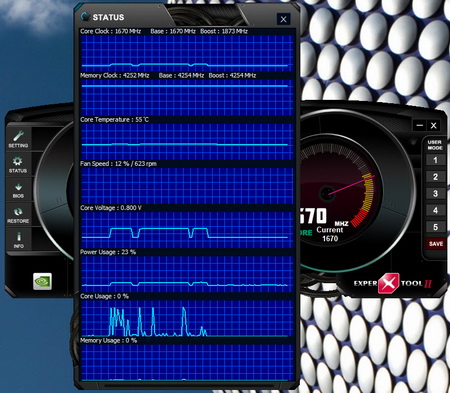
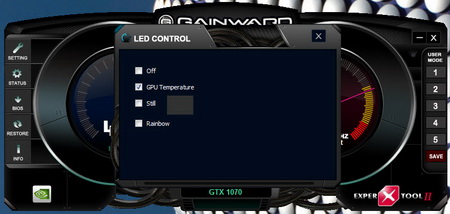
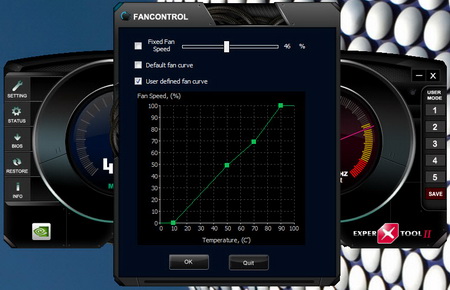
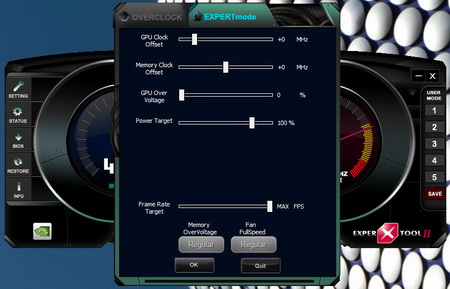
From here you can check the status of the card, control the LED (on/off/still color/rainbow), adjust the fan speed (fixed/default/custom) and overclock the card.
TEST BED
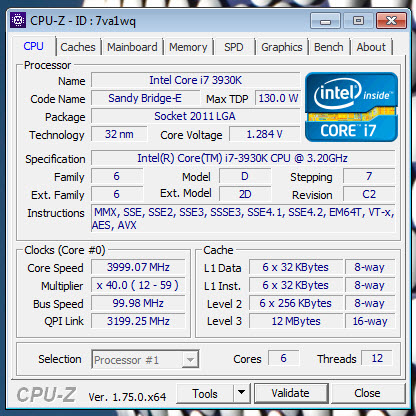

TESTING METHODOLOGY
Starting from scratch is not easy so as expected our GPU database will not include models not in our procession any longer. Of course all tests were performed using the latest drivers this time over but due to time issues and also because some older models are no longer in our hands sometimes this will simply not be possible (the drivers used will always be placed next to each card). The cards tested today and currently in our database are the following ones:
GAINWARD GeForce GTX 650 Ti BOOST 2GB GS - ForceWare v353.30
GAINWARD GeForce GTX 670 Phantom 2GB - ForceWare v353.30
ASUS GeForce GTX 960 Strix 2GB - ForceWare v353.30
MSI GeForce GTX 960 Gaming 2GB - ForceWare v353.30
EVGA GeForce GTX 970 FTW ACX 2.0 4GB - ForceWare 353.30
ASUS Radeon R9 280X DirectCU II 3GB - Catalyst 15.6 Beta
GIGABYTE GeForce GTX 970 WindForce 3X OC 4GB – ForceWare v353.30
Inno3D GeForce GTX 980 iChill Ultra 4GB – ForceWare v353.30
MSI Radeon R9 380 Gaming 2G – Catalyst 15.8 Beta
ASUS Radeon R9 Fury STRIX 4GB – Crimson 16.3.2
HIS Radeon R7 360 GREEN iCooler OC 2GB – Crimson 16.6.1
NVIDIA GeForce GTX 1080 Founders Edition 8GB – ForceWare v368.81
GAINWARD GeForce GTX 1070 Phoenix GLH 8GB – ForceWare v368.95
Once again the screen used for all the benchmarks is our primary NEC 30" 3090WQXi LCD with a maximum resolution of 2560x1600. However we decided to change things to make it easier for us to perform tests so our testing methodology now includes a total of 7 games benchmarked in two different resolutions (2560X1600 and 1920X1200) and with all quality settings set to maximum (AA and AF are not applicable in our tests). The 7 game titles we're currently using consist from both old ones we've used in the past and new ones including Alien Isolation, Bioshock Infinite, Battlefield 4, Metro Last Light, RYSE Son Of Rome, The Witcher 3 Wild Hunt and Tom Clancy’s The. Power saving is disabled in the cards we’re testing (or turned to maximum performance) and all tests are repeated a total of 6 times and in a fresh Windows 7 Ultimate Service Pack 1 installation. Room temperature is as usual controlled and steady at 23 degrees Celsius for all tests and to record the temperatures of the cards we used AIDA64 (former Everest Ultimate by Lavalys) and GPU-Z. Recording noise levels is done with an ExTech HD600 dBA meter from a distance of no more than 5-10cm away while power consumption is measured using both with a voltmeter and an amperometer (GPU-Z sometimes comes in handy in this as well).
TEST RESULTS – ALIEN ISOLATION
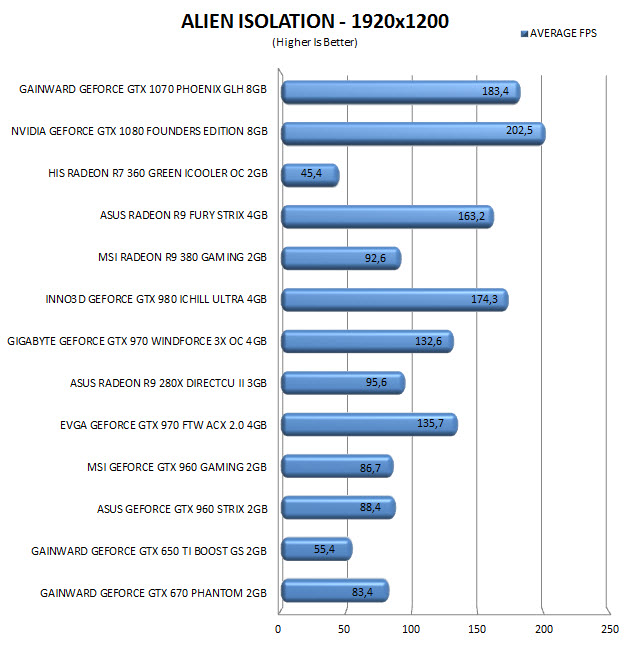
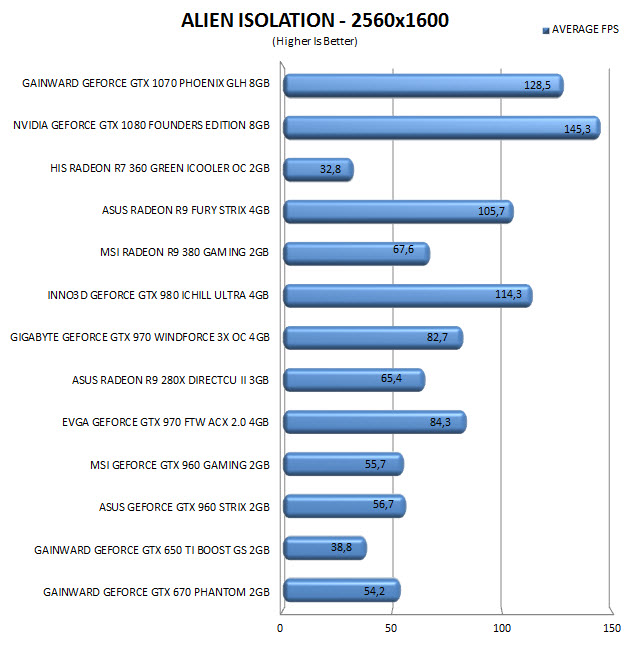
TEST RESULTS – RYSE SON OF ROME
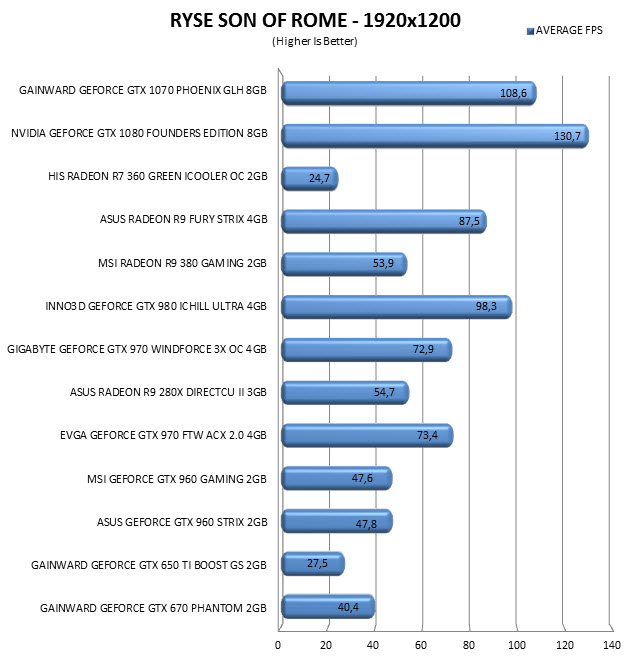
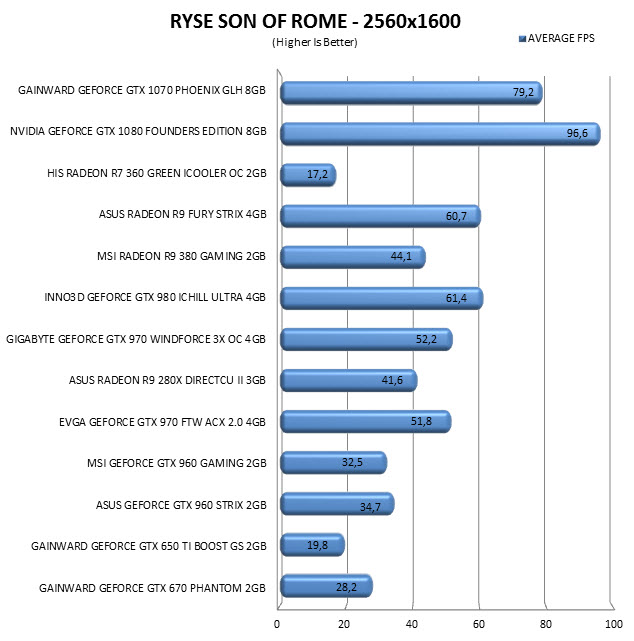
TEST RESULTS – BATTLEFIELD 4
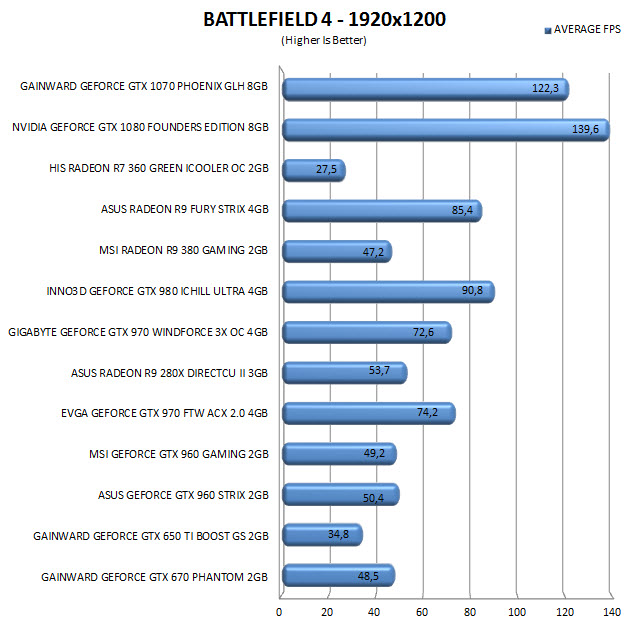
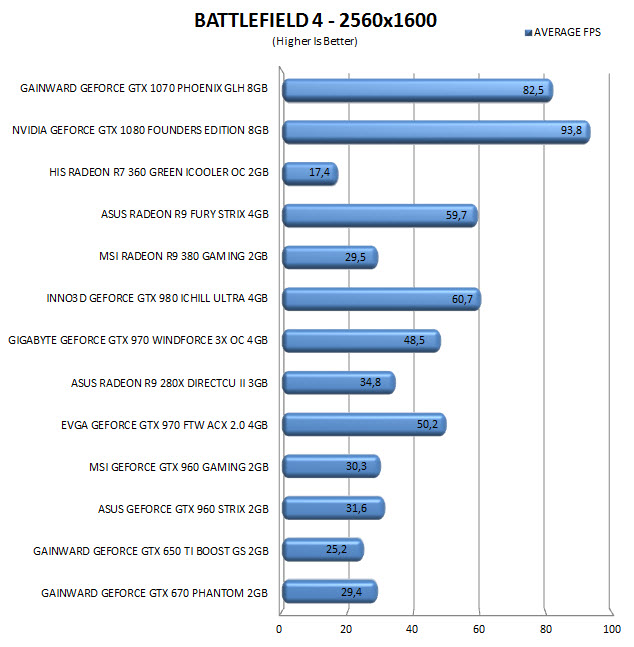
TEST RESULTS – BIOSHOCK INFINITE
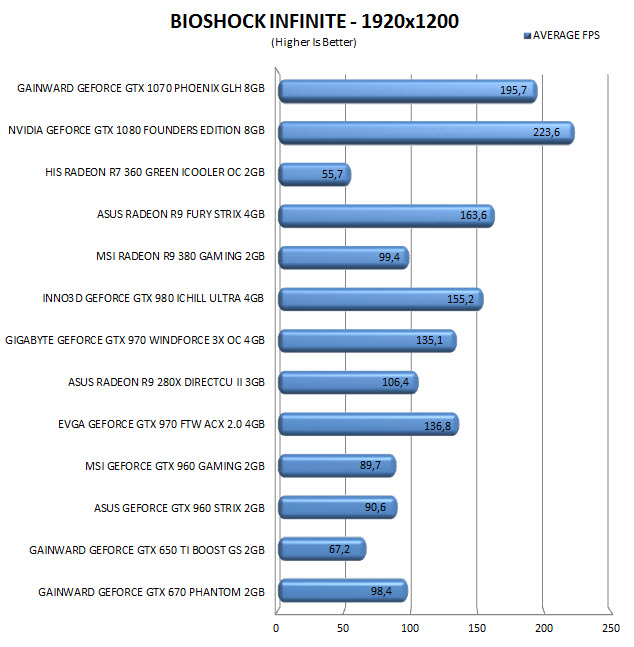
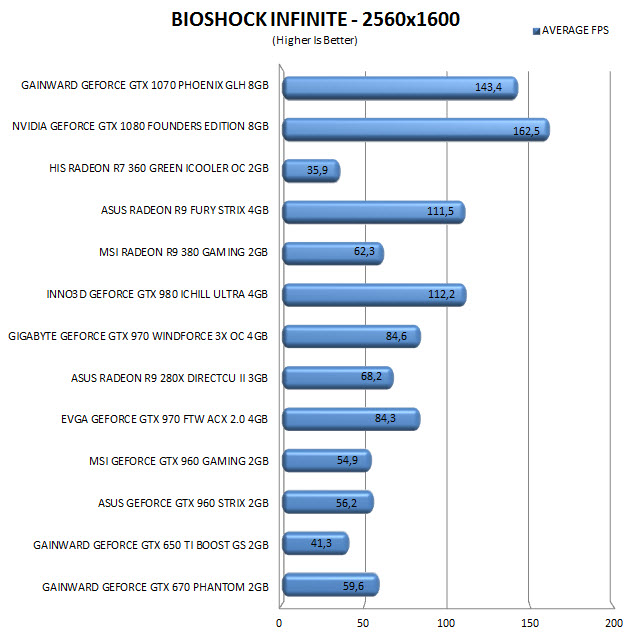
TEST RESULTS – METRO LAST LIGHT
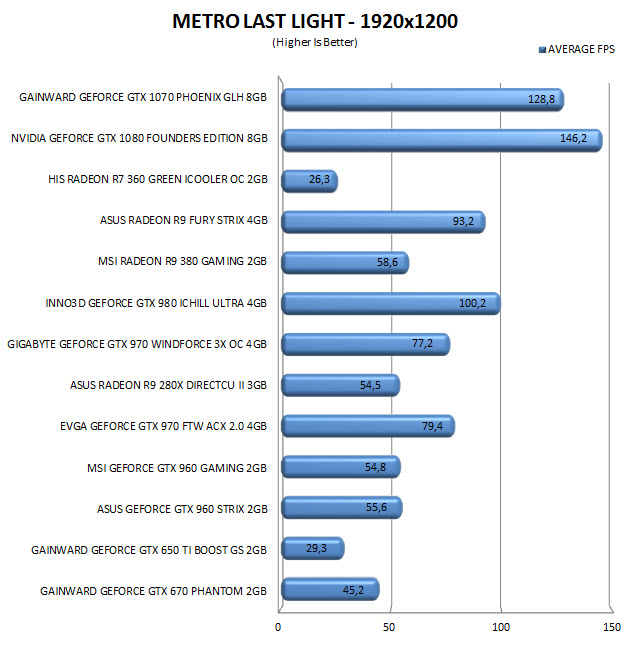
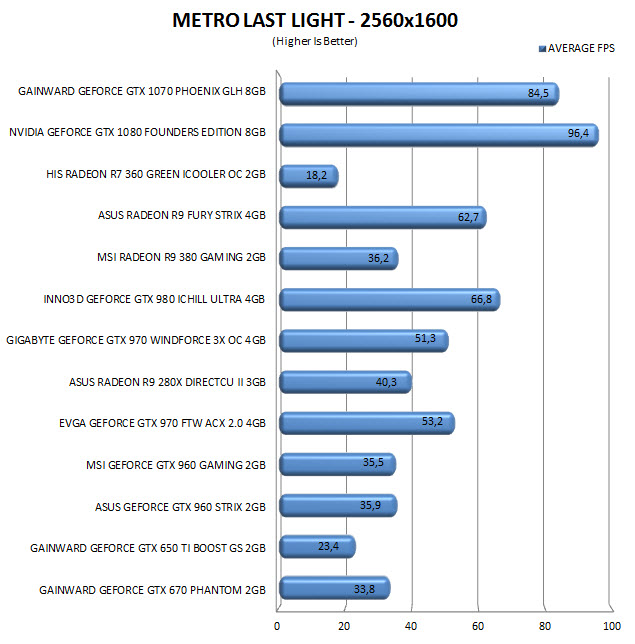
TEST RESULTS – TOM CLANCYS THE DIVISION
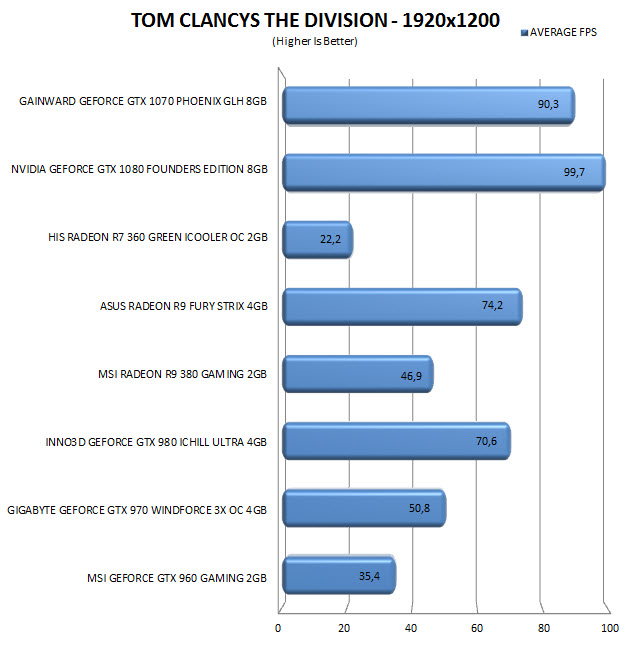
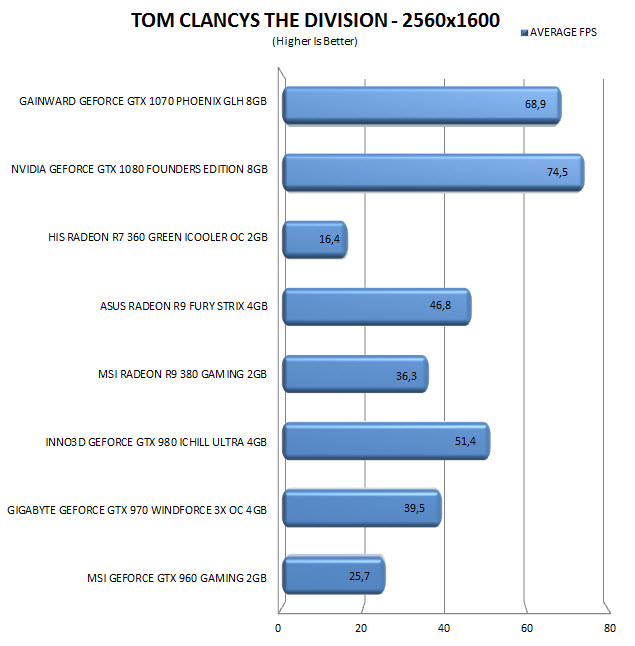
TEST RESULTS – THE WITCHER III WILD HUNT
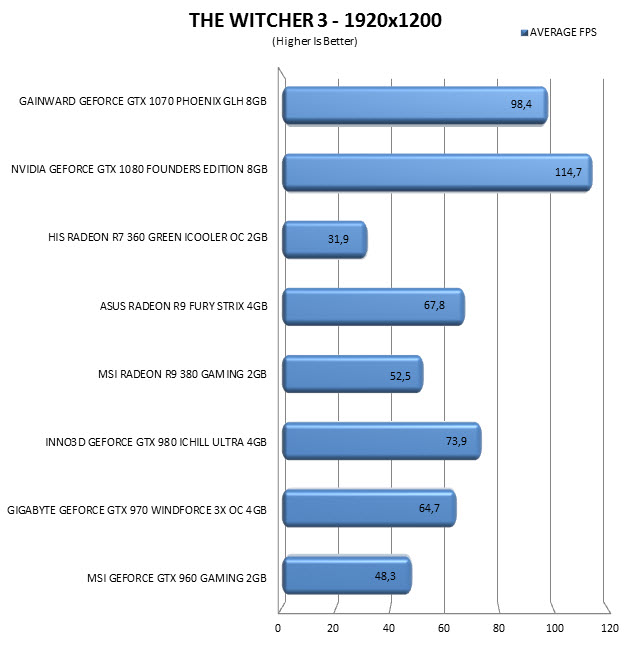
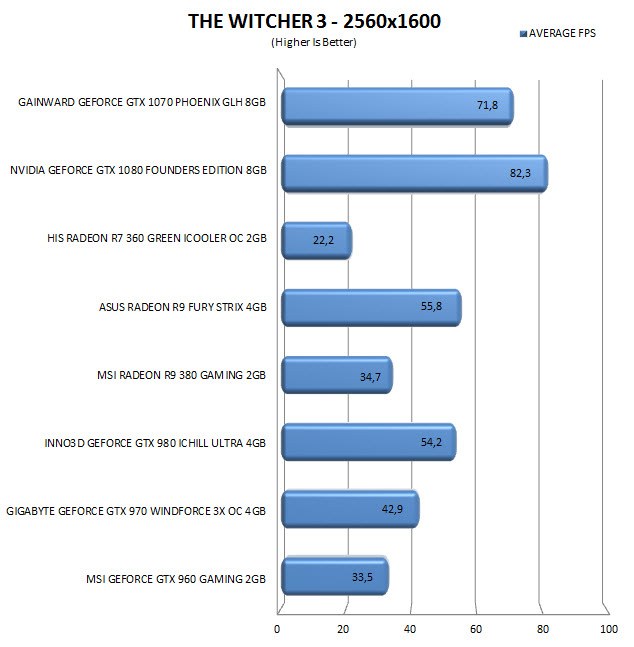
TEST RESULTS – POWER CONSUMPTION / NOISE LEVELS / TEMPERATURES



TEST RESULTS – OVERCLOCKING
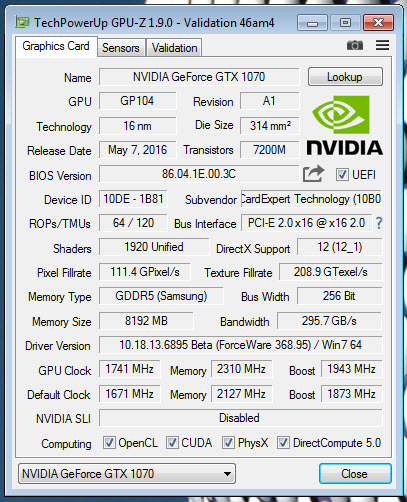
Via Gainwards EXPERTool we managed to further push the base clock by 60MHz (roughly 4% improvement on boost clocks) and the memory clock to 2310MHz (almost 9% up).
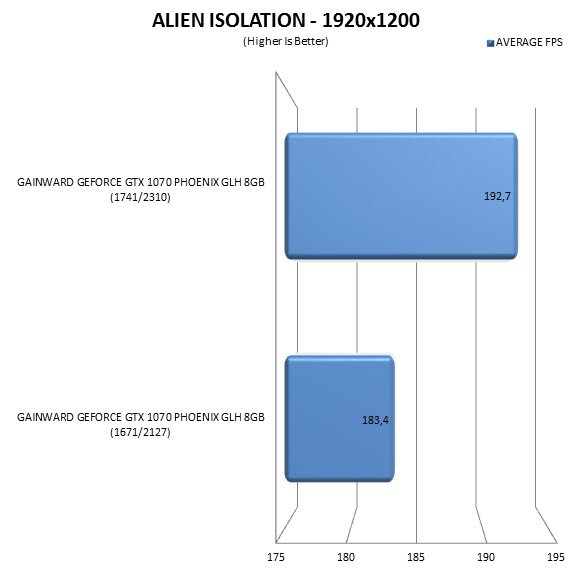
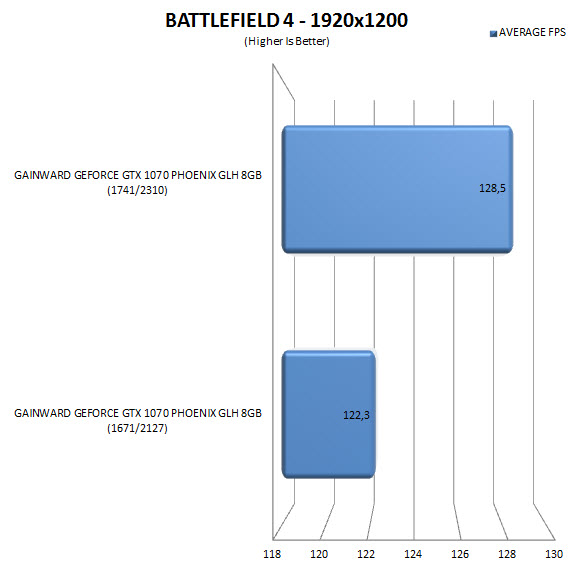
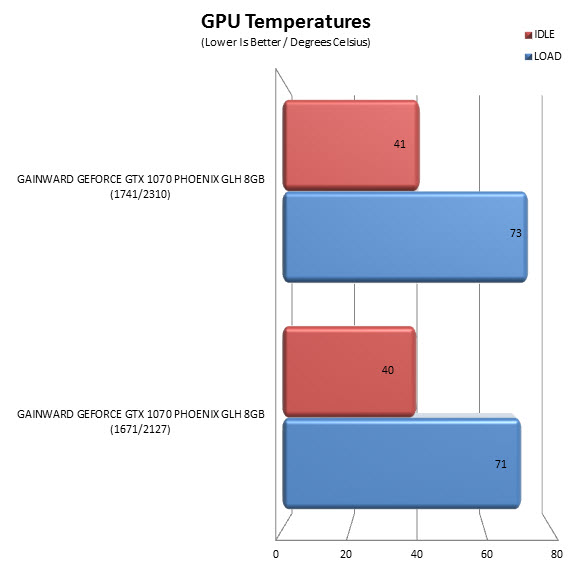
Our OC yielded roughly a 5% boost in both Alien Isolation and Battlefield 4 (temperatures increased just 2 degrees under load).
CONCLUSION
There’s really not much to say about the GeForce GTX 1070 Phoenix GLH 8GB by Gainward that isn’t showcased in our charts down to the slightest detail. What really impressed us about this card(just like with the GTX 1080) was the excellent performance levels accompanied by a very low power consumption even at load but this time over that wasn’t all. I am of course referring to the custom cooling system of the Phoenix Golden Sample model since it allowed us to record very low temperature and noise levels even at extreme loads. Unfortunately because of this cooling system the GeForce GTX 1070 GLH 8GB model requires 3 PCI slots to install and that may not be optimal for some users (I don’t like losing PCIe slots for example). I guess we can’t have it all however (for example I’d choose this cooler over the one used in the 2-slot Founders Edition any day of the week) so let’s move to pricing.
While I type these lines the GeForce GTX 1070 Phoenix GLH 8GB graphics card retails for 469.48Euros inside the EU (Amazon.de) and as usual for a product by Gainward we were unable to track it inside the USA (there should have an equivalent of this card in the USA market by Gainwards sister company Palit). All things said and done the GeForce GTX 1070 currently holds an excellent price/performance ratio (even more so than the GTX 1080) and that goes double for the Phoenix Goes Like Hell by Gainward which is why it receives our Platinum Award (too bad we don’t have a Titanium award for such a card – yet).

PROS
- Solid Build Quality
- Excellent Performance
- Features (Fast Sync / Simultaneous Multi-Projection / Ansel / HDR / Asynchronous Compute / Boost 3.0)
- Design (For Some)
- Low Power Consumption / Noise Levels / Temperatures
- Factory Overclock
- HDMI v2.0 / 3x DisplayPort v1.4 / DVI-D
- Price (Compared To The Founders Edition)
- 8GB GDDR5
CONS
- Requires 3 PCI Slots

 O-Sense
O-Sense





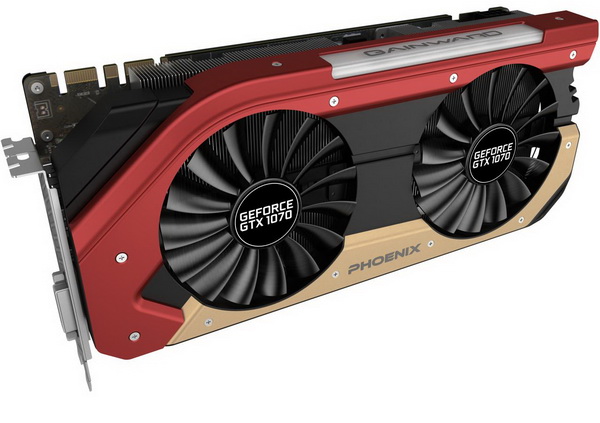
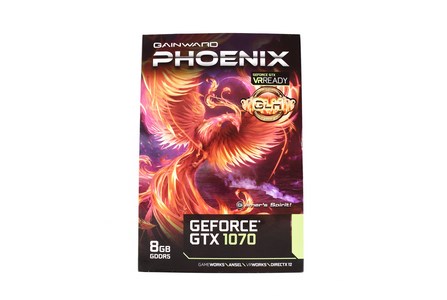
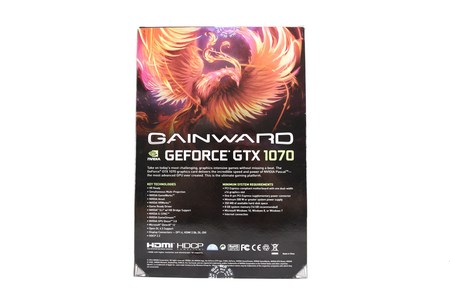
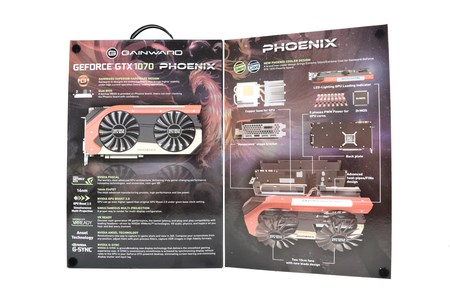
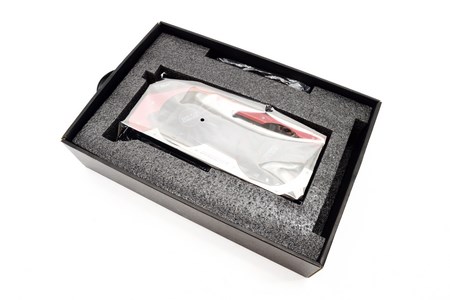
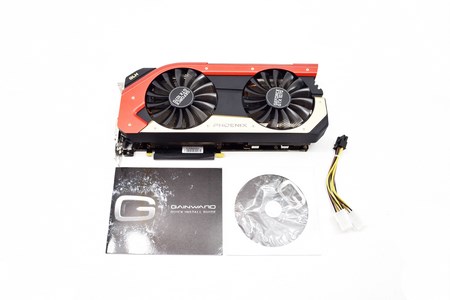
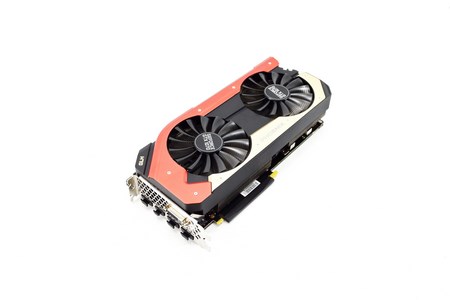
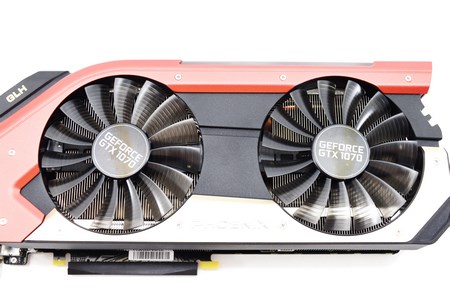
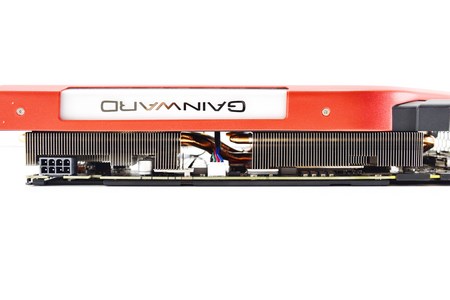
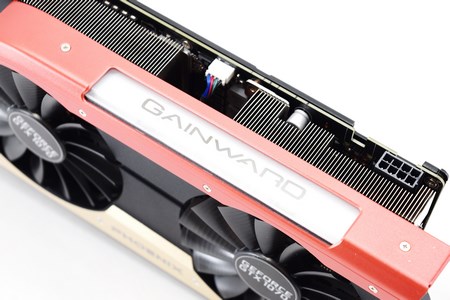
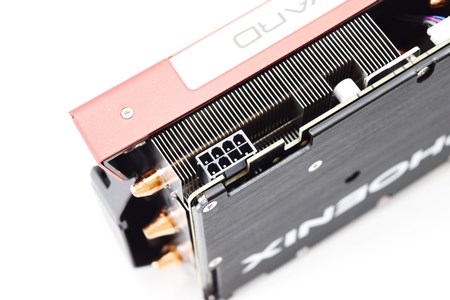
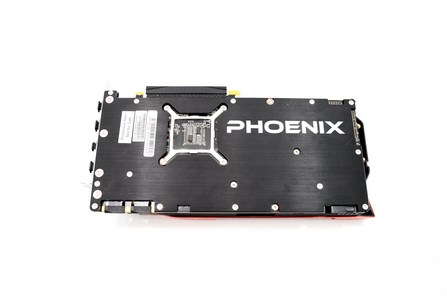
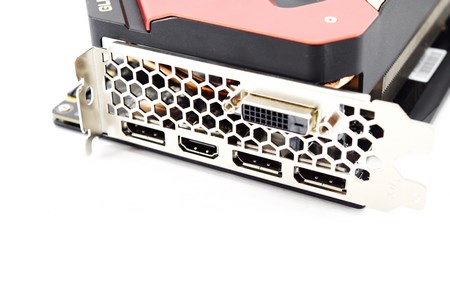
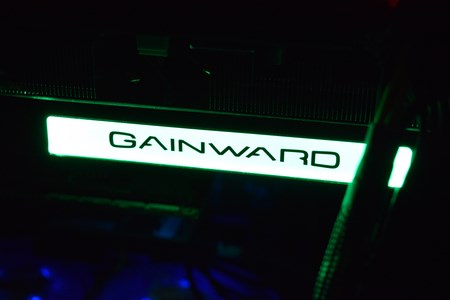
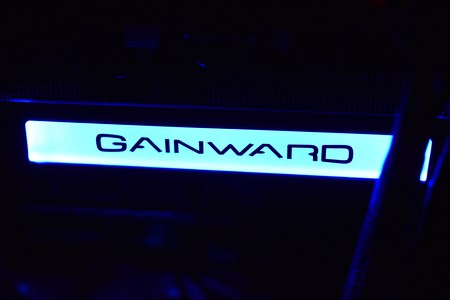
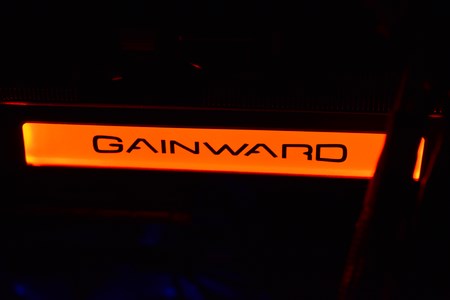
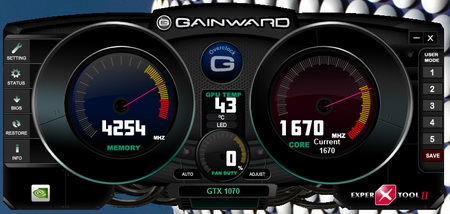
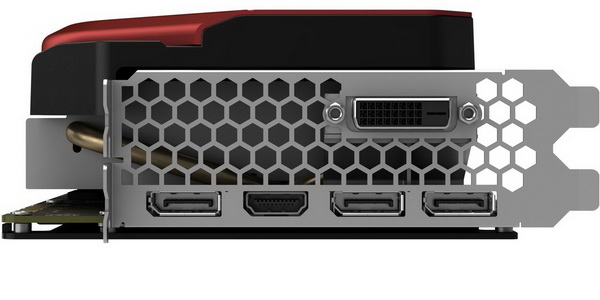


.png)

